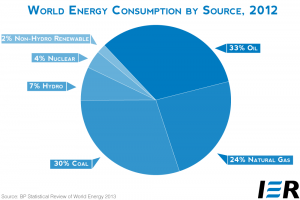Energy consumption is rising rapidly. The exponential rise in population and technology means that this consumption won’t be decreasing any time soon. Most of this energy consumption comes in the form of electricity. An Iphone eats up as much electricity as a refrigerator (taking into account servers and all energy use behind the scenes). That is a lot of added energy use even in small family homes. Energy consumption is not going to decrease any time in the near future. Clean energy and green technologies are making an effort, but barely making a dent in total production. Non-hydroelectric energy (created from wind, solar and geothermal power) is sustainable, but makes up less that 2% of total energy production. The use of coal and oil make up over 50%. The coal and oil industries dominate this market. Solar and wind get critiqued for taking up too much land and being unreliable. Solar power loses its flare during winter months and windy days are just as likely as calm days. This uncertainty in energy creation makes wind and solar technologies difficult to look to as a reasonable sources of electricity to overtake coal and oil. Nuclear currently makes up 8-10% of total energy production. It is often feared because of disasters like Chernobyl and Fukushima. The effects of a meltdown, the stockpile of radioactive waste, and the threat of weaponizing nuclear power have slowed the progress of this energy.
 http://www.instituteforenergyresearch.org/wp-content/uploads/2013/06/bp-review-blog-post-graphs.png
http://www.instituteforenergyresearch.org/wp-content/uploads/2013/06/bp-review-blog-post-graphs.png
This is reasonable. Conventional nuclear fission creates large amounts of waste that last tens of thousands of years. The heat and pressure necessary to sustain the reaction means that when power is lost to the reactors, the consequences can be fatal. According to the UN and other groups that estimated the damages, on the day of the meltdown, 130 people died from the Chernobyl accident. Several thousand more have died from radiation related issues. The Energy Collective reported that the estimated deaths caused directly by radiation from the Fukushima disaster range from 15-1000 people over several years. The high heat and pressure makes nuclear reactors volatile and dangerous. Though this is true, deaths from coal and oil are staggering. Coal and oil kill roughly 60 and 35 people respectively per terrawatt hour produced. That figure is next to zero for nuclear power and that is using the conventional reactors. The Economist this week discusses a form of reaction that may give nuclear a clean slate. Thorium is an element that shares many characteristics with Uranium. The differences are clear. The reaction created by Thorium can be successful at slower rates (fast reactions are often used, but are highly inefficient), using a third of the heat and no added pressure. This decreases the risks of a meltdown. The reaction created by Thorium needs a single neutron as a catalyst. Once the reactions starts it is self sustaining. Nuclear reactors using Thorium produce a fraction of the waste with a shorter half-life (from tens of thousands of years to just several hundred years) and little risk in meltdowns like ones in the past. Another feature, and reason for its underdevelopment, is that the reaction from Thorium cannot be used to make bombs. This discouraged research during the Cold War. Nuclear power was first looked to for weapons, not for energy use. Switching to Thorium could remove all the setbacks from conventional fission. It is also four times as prevalent in the Earth’s crust as Uranium (and only a small percent of that Uranium is fissile). Thorium is “reactor-ready” as soon as it is removed from the earth. The benefits of Thorium relative to other elements for nuclear power seem endless.
Introducing Thorium as a form of energy production is already happening. China and India are leading the way in research and development. While a majority of nuclear power is still done using uranium reactions, the switch to Thorium could mean safer, cheaper and more efficient energy production than ever before. The fear of a dangerous substance beyond our control is coming to an end. Nuclear power may be the only source of energy that can keep up with our hunger for energy. Thorium could give us the ability to rely more heavily on nuclear power and to move away from coal and oil.

“Another feature, and reason for its underdevelopment, is that the reaction from Thorium cannot be used to make bombs. This discouraged research during the Cold War. Nuclear power was first looked to for weapons, not for energy use.”
So, switching to Thorium would be a loss of a technological externality of sorts? Sounds like a good example of potential economies of scope (if the state is looking to produce both nuclear energy and nuclear weapons).
Good article.